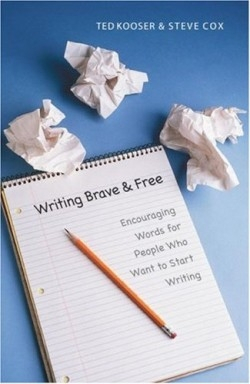Writing Brave and Free
Encouraging Words for People Who Want to Start Writing
What a treasure to have a second how-to book of this caliber enter the world for developing writers. This new handbook is like its predecessor in its most important characteristics. Following the format of co-author Kooser’s first how-to book The Poetry Home Repair Manual, this is a practical, down-to-earth, advice-driven collection of smart, unpretentious chapters on the work of becoming a writer. However, this book will have wider appeal than Kooser’s single-authored previous book because this is for all writers, not just poets.
From the beginning, these two authors continue the format set in the previous book, but to an even greater degree. Readers will find a well-organized, easy-to-follow structure, which moves from a positive “Yes, You Can” (section 1) approach to the essential, often overlooked subject of the final chapter: “The Business of Writing” (section 8). In each chapter, in addition to the simple instructions for beginning, the authors supply numerous examples of what other writers have done to deal with the problem areas of writing. Telling examples include how Alfred Kazan organized his memoir Walker in the City in just four sections (Getting Organized), the room Ralph Waldo Emerson created that nurtured his writing (It’s a Figure of Speech), or an analysis of opening lines from works by Flannery O’Conner and D.M. Thomas (Suspense). It also includes a section on physical exercises which help writers clear their minds. The final section on business is thorough without being intimidating. It offers helpful lists on what comes first, a model query letter, and addresses the challenging process of where to submit. The section on self-publishing and electronic publishing will be especially important to today’s younger writers.
The greatest strength of this book is its friendly, don’t-be-afraid-we’ll-help-you tone, a must for people who are just beginning their writing endeavors. It doesn’t assume anything and as a result, leads new writers through the pitfalls with solid suggestions about fear of failure (“Build rejection into your expectations”) and the use and overuse of adjectives. The authors speak enthusiastically of the habit of writing—write every day and if you’re stuck, lower your standards, but don’t stop writing. The one small shortcoming of the book is that there are only two chapters covering the all-important practice of revision. However, so many essential topics on how to get started and keep going are covered so comprehensively that it will be an essential tool for anyone considering the adventure of writing.
Reviewed by
Anne-Marie Oomen
Disclosure: This article is not an endorsement, but a review. The publisher of this book provided free copies of the book to have their book reviewed by a professional reviewer. No fee was paid by the publisher for this review. Foreword Reviews only recommends books that we love. Foreword Magazine, Inc. is disclosing this in accordance with the Federal Trade Commission’s 16 CFR, Part 255.

